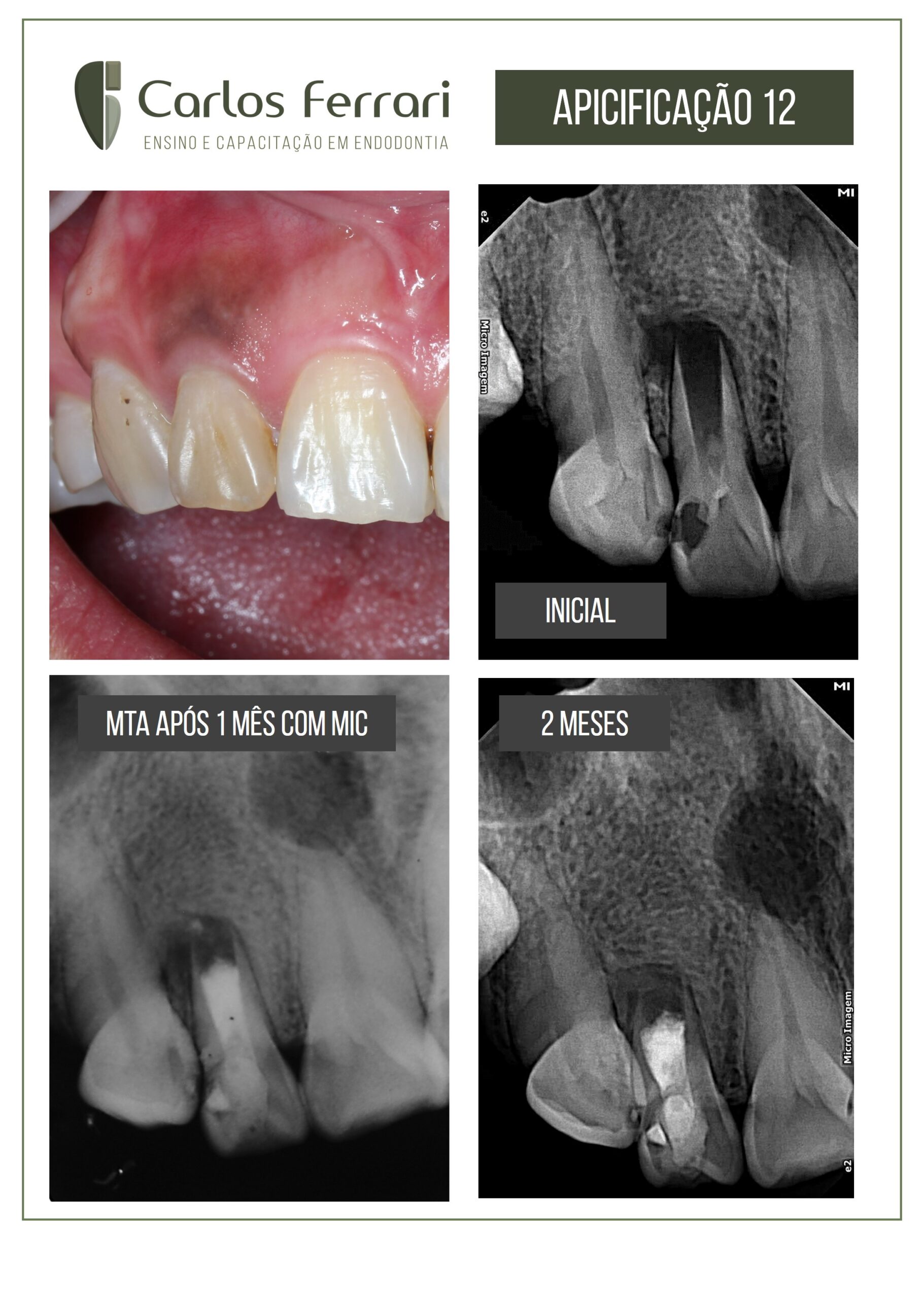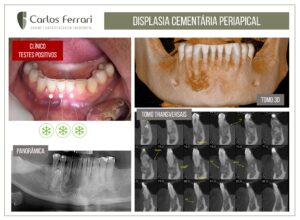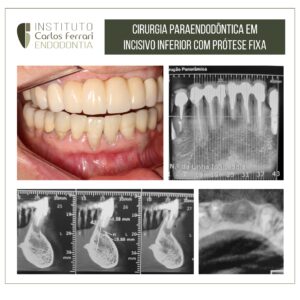Apicificação em dente em dente com rizogênese incompleta e necrose pulpar em paciente adulto.
Paciente 22 anos, sexo feminino, procurou atendimento para tratamento endodôntico do dente 12. O paciente não apresentava quaisquer sinal ou sintoma.
No exame clínico, nada digno de nota e teste de vitalidade pulpar positivo nos dentes anteriores com exceção do elemento 12. No exame radiográfico, presença de imagem radiolúcida periapical difusa e dente com formação radicular incompleta, em estágio de Nolla compatível com o 7.
Por não haver a possibilidade de controle futuro, por viagem, optou-se pela apicificação. Foi realizado preparo e descontaminação com hipoclorito de sódio 2,5% e EDTA e medicação com hidróxido de cálcio por 1 mês. Na segunda sessão, a MIC foi removida com soro e EDTA e agitação e realizada então a colocação de um tampão apical de hidróxido de cálcio, seguido por preenchimento do canal com MTA e selamento.
Caso conduzido pelo aluno Karlon Rodrigues da turma VII, especialização em endodontia da HPG Brasília.
In: APICIFICAÇÃO DE INCISIVOS CENTRAIS SUPERIORES USANDO HIDRÓXIDO DE CÁLCIO: RELATO DECASO. Saúde, Santa Maria, vol 35, n 1: p 16-20 , 2009
Uma das possíveis conseqüências do trauma em dentes permanentes jovens é a necrose pulpar. Se o dente tiver rizogênese
imcompleta, a técnica do tratamento endodôntico deve ser realizada de maneira a promover o desenvolvimento radicular as expensas da bainha epitelial de Hertwig quando esta possuir células viáveis (apicigênese), ou através do emprego do hidróxido de cálcio para que ocorra a deposição de tecido duro na região apical( apicificação) (Heithersay,1975).
A apicificação “induz uma barreira de tecido duro em uma raiz com ápice aberto ou a continuação do desenvolvimento apical de uma raiz incompleta em dentes com polpa necrótica” (American Association of Endodontists, 2003).
Diferentestécnicas de apicificação têm sido propostas, sendo a mais comum a que usa o hidróxido de cálcio por um período
indeterminado de tempo (Frank, 1966; Estrela et al. 2001).
O hidróxido de cálcio tem sido indicado para apicificação, pois o seu pH alcalino e sua presença física dentro do canal
apresentam um potente efeito antibacteriano, inibindo a atividade osteoclástica e prevenindo a entrada de exudato e tecido de
granulação. Esta situação propicia a formação de tecido mineralizado junto ao ápice radicular (Cvek, 1974). Segundo
Felippe (2005), pastas de hidróxido de cálcio têm sido usadas para obter a desinfecção do canal e a indução da formação de uma barreira de tecido calcificado na região apical de dentes que se apresentam despolpados e com rizogênese incompleta.
O uso do hidróxido de cálcio foi primeiro introduzido por Kaiser em 1964 e popularizado por Frank em 1966 que propôs misturar este material com PMCC para induzir a formação de uma barreira de tecido calcificado no ápice.
O hidróxido de cálcio pode ser associado a várias outras substâncias, com a finalidade de potencializar suas
propriedades, e com os mais variados veículos: viscosos ou não. Ao longo de muitos anos diversas associações foram
testadas, no entanto sem evidências de que um produto seja mais vantajoso que outro (Andreasen, 1984; Leonardo et al,
1993).
Apicificação.





